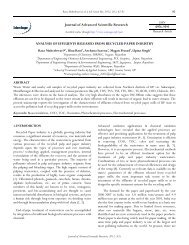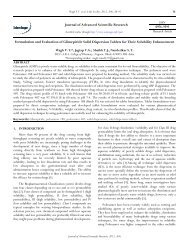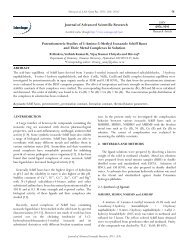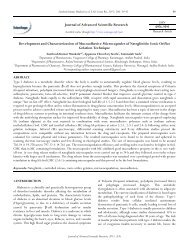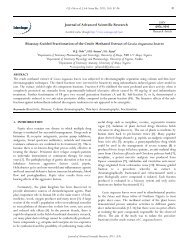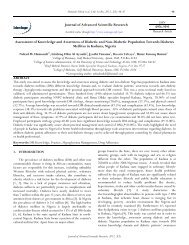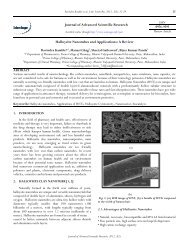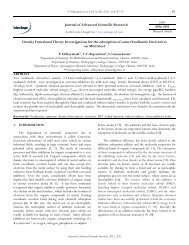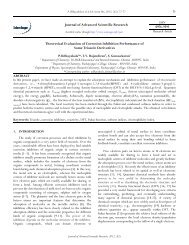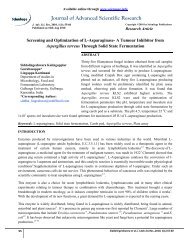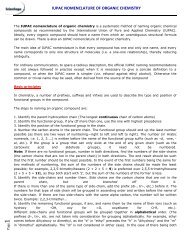theoretical study using dft calculations on inhibitory ... - Sciensage.info
theoretical study using dft calculations on inhibitory ... - Sciensage.info
theoretical study using dft calculations on inhibitory ... - Sciensage.info
You also want an ePaper? Increase the reach of your titles
YUMPU automatically turns print PDFs into web optimized ePapers that Google loves.
Udhayakala et al, J Adv Sci Res, 2013, 4(2): 31-37 31<br />
Journal of Advanced Scientific Research<br />
Available <strong>on</strong>line through http://www.sciensage.<strong>info</strong>/jasr<br />
ISSN<br />
0976-9595<br />
Research Article<br />
THEORETICAL STUDY USING DFT CALCULATIONS ON INHIBITORY ACTION OF<br />
SOME PYRAZOLE DERIVATIVES ON STEEL<br />
P.Udhayakala a* , T.V. Rajendiran b , S. Gunasekaran c<br />
a Department of Chemistry, Dr.M.G.R. Educati<strong>on</strong>al and Research Institute, Chennai -600095, India<br />
b Department of Chemistry, Pachaiyappa’s College, Chennai - 600 030, India<br />
c Department of Physics, Spectrophysics Research Laboratory, Pachaiyappa’s College, Chennai- 600 030, India<br />
*Corresp<strong>on</strong>ding author: udhayakala_kumar@yahoo.in<br />
ABSTRACT<br />
The inhibiti<strong>on</strong> activity of two pyrazole derivatives, namely 1-{[benzyl-(2-cyano-ethyl)amino]methyl}-5-methyl-1H-pyrazole-3-<br />
carboxylic acid methyl ester (P1) and 1-{[benzyl-(2-cyano-ethyl)amino] methyl}-5-methyl-1H-pyrazole-3-carboxylic acid ethyl<br />
ester (P2) has been performed <str<strong>on</strong>g>using</str<strong>on</strong>g> density functi<strong>on</strong>al theory (DFT) at the B3LYP/6-31G(d,P) basis set level in order to elucidate<br />
the different inhibiti<strong>on</strong> efficiencies and reactive sites of these compounds as corrosi<strong>on</strong> inhibitors. The calculated structural<br />
parameters correlated to the inhibiti<strong>on</strong> efficiency are the fr<strong>on</strong>tier molecular orbital energies E HOMO (highest occupied molecular<br />
orbital energy), E LUMO (lowest unoccupied molecular orbital energy), energy gap (ΔE), dipole moment (μ), hardness (η), softness<br />
(S), the absolute electr<strong>on</strong>egativity (χ), the electrophilicity index (ω) and the fracti<strong>on</strong>s of electr<strong>on</strong>s transferred (ΔN) from pyrazole<br />
molecules to ir<strong>on</strong> . The local reactivity has been analyzed through the c<strong>on</strong>densed Fukui functi<strong>on</strong> and c<strong>on</strong>densed softness indices<br />
<str<strong>on</strong>g>using</str<strong>on</strong>g> populati<strong>on</strong> analysis. The calculated % IE was found to be in agreement with experimental corrosi<strong>on</strong> inhibiti<strong>on</strong> efficiencies.<br />
Keywords: Corrosi<strong>on</strong> inhibiti<strong>on</strong>, Pyrazole , reactivity, DFT, Fukui functi<strong>on</strong>, softness indices.<br />
1. INTRODUCTION<br />
Corrosi<strong>on</strong> of steel is an inevitable process during cleaning,<br />
pickling, scaling and etching in acidic medium. The <str<strong>on</strong>g>study</str<strong>on</strong>g> of<br />
corrosi<strong>on</strong> processes and their inhibiti<strong>on</strong> by organic compounds<br />
is a very active field of research [1]. Over the years,<br />
c<strong>on</strong>siderable efforts have been deployed to find suitable<br />
corrosi<strong>on</strong> inhibitors of organic origin in various corrosive media<br />
[2]. It has been comm<strong>on</strong>ly recognized that organic inhibitor<br />
usually promotes formati<strong>on</strong> of a chelate <strong>on</strong> the metal surface,<br />
which includes the transfer of electr<strong>on</strong>s from the organic<br />
compounds to metal, forming coordinate covalent b<strong>on</strong>d during<br />
such chemical adsorpti<strong>on</strong> process [3]. Most of the organic<br />
inhibitors c<strong>on</strong>taining nitrogen, oxygen, sulfur atoms, and<br />
multiple b<strong>on</strong>ds in their molecules facilitate adsorpti<strong>on</strong> <strong>on</strong> the<br />
metal surface [4, 5]. Researchers c<strong>on</strong>clude that the adsorpti<strong>on</strong><br />
<strong>on</strong> the metal surface depends mainly <strong>on</strong> the physicochemical<br />
properties of the inhibitor, such as the functi<strong>on</strong>al group,<br />
molecular electr<strong>on</strong>ic structure, electr<strong>on</strong> density at the d<strong>on</strong>or<br />
atom, orbital character and the molecular size [6]. The<br />
planarity and the l<strong>on</strong>e electr<strong>on</strong> pairs in the hetero atoms are<br />
important features that determine the adsorpti<strong>on</strong> of molecules<br />
<strong>on</strong> the metallic surface [7].<br />
The geometry of an inhibitor also has an important<br />
influence in determining its adsorbability at the metal-soluti<strong>on</strong><br />
interface. Molecules that are planar have a greater tendency to<br />
adsorb at the metal surface than molecule that has less planar<br />
geometry [8]. Quantum chemical <str<strong>on</strong>g>calculati<strong>on</strong>s</str<strong>on</strong>g> have been widely<br />
used to <str<strong>on</strong>g>study</str<strong>on</strong>g> reactive mechanism and also an effective tool in<br />
the analysis and elucidati<strong>on</strong> of many experimental observati<strong>on</strong>s.<br />
They have been proved to be a very powerful tool for <str<strong>on</strong>g>study</str<strong>on</strong>g>ing<br />
corrosi<strong>on</strong> inhibiti<strong>on</strong> mechanism [9, 10].<br />
Pyrazole derivatives have attracted c<strong>on</strong>siderable attenti<strong>on</strong> in<br />
the recent years for their diverse biological [11] and also for<br />
their anticancer activities [12]. In literature, a few reports have<br />
been presented <strong>on</strong> the use of pyrazole and some of its<br />
derivatives as corrosi<strong>on</strong> inhibitors in different media [13, 14].<br />
Although experimental work of L. Herrag et al. [15] provide<br />
valuable <strong>info</strong>rmati<strong>on</strong> <strong>on</strong> the corrosi<strong>on</strong> inhibiti<strong>on</strong> efficiency of 1-<br />
{[benzyl-(2-cyano-ethyl)amino]methyl}-5-methyl-1H-pyrazole-<br />
3-carboxylic acid methyl ester (P1) and 1-{[benzyl-(2-cyanoethyl)amino]methyl}-5-methyl-1H-pyrazole-3-carboxylic<br />
acid<br />
ethyl ester (P2), a deep understanding of the inhibiti<strong>on</strong><br />
property remain unclear. The objective of the present paper is<br />
to extend the <str<strong>on</strong>g>study</str<strong>on</strong>g> of L. Herrag et al. [15] by analyzing the<br />
inhibiti<strong>on</strong> efficiency of P1and P2 <strong>on</strong> <str<strong>on</strong>g>theoretical</str<strong>on</strong>g> chemical<br />
parameters such as the energies of highest occupied molecular<br />
orbital (E HOMO ) and the lowest unoccupied molecular orbital<br />
Journal of Advanced Scientific Research, 2013, 4(2)
(E LUMO ), the energy gap (ΔE) between E HOMO and E LUMO , dipole<br />
moment (μ), i<strong>on</strong>izati<strong>on</strong> potential (I), electr<strong>on</strong> affinity (A),<br />
electr<strong>on</strong>egativity (χ), global hardness (η), softness (S), the<br />
global electrophilicity (ω), the fracti<strong>on</strong> of electr<strong>on</strong>s transferred<br />
(ΔN) and back d<strong>on</strong>ati<strong>on</strong>(ΔE). The local reactivity has been<br />
analyzed by means of the Fukui indices, since they indicate the<br />
reactive regi<strong>on</strong>s, in the form of the nucleophilic and<br />
electrophilic behaviour of each atom in the molecule <str<strong>on</strong>g>using</str<strong>on</strong>g> DFT<br />
<str<strong>on</strong>g>calculati<strong>on</strong>s</str<strong>on</strong>g><br />
2. MATERIAL AND METHODS<br />
2.1 Quantum Chemical Calculati<strong>on</strong><br />
In order to explore the <str<strong>on</strong>g>theoretical</str<strong>on</strong>g>-experimental<br />
c<strong>on</strong>sistency, quantum chemical <str<strong>on</strong>g>calculati<strong>on</strong>s</str<strong>on</strong>g> were performed<br />
Udhayakala et al, J Adv Sci Res, 2013, 4(2): 31-37 32<br />
<str<strong>on</strong>g>using</str<strong>on</strong>g> Gaussian-03 software package [16]. Complete geometrical<br />
optimizati<strong>on</strong>s of the investigated molecules are performed <str<strong>on</strong>g>using</str<strong>on</strong>g><br />
density functi<strong>on</strong>al theory(DFT) with the Becke’s three<br />
parameter exchange functi<strong>on</strong>al al<strong>on</strong>g with the Lee– Yang–Parr<br />
n<strong>on</strong>local correlati<strong>on</strong> functi<strong>on</strong>al (B3LYP) [17,18] at 6-31G(d,p)<br />
basis set level. These <str<strong>on</strong>g>calculati<strong>on</strong>s</str<strong>on</strong>g> have been widely used to<br />
<str<strong>on</strong>g>study</str<strong>on</strong>g> reacti<strong>on</strong> mechanisms [19]. They have also been proved to<br />
be a very powerful tool for <str<strong>on</strong>g>study</str<strong>on</strong>g>ing inhibiti<strong>on</strong> of the corrosi<strong>on</strong><br />
of metals [20, 21). Recently, density functi<strong>on</strong>al theory (DFT)<br />
has been used to analyze the characteristics of the<br />
inhibitor/surface mechanism and to describe the structural<br />
nature of the inhibitor in the corrosi<strong>on</strong> process [22]. The<br />
chemical and optimized structures of the compounds studied are<br />
given in fig 1. and fig. 2.<br />
1-{[benzyl-(2-cyano-ethyl)amino]methyl}-5-methyl-1H-pyrazole-3-<br />
carboxylic acid methyl ester (P1)<br />
1-{[benzyl-(2-cyano-ethyl)amino]methyl}-5-methyl-1H-pyrazole-3-<br />
carboxylic acid ethyl ester (P2)<br />
Fig.1: Names, molecular structure and the abbreviati<strong>on</strong> of the inhibitors investigated<br />
P1<br />
P2<br />
Fig. 2: Optimized structure of P1 and P2 calculated with the B3LYP/6-31G (d,p)<br />
2.2. Global and local reactivity descriptors<br />
Density functi<strong>on</strong>al theory (DFT) [23] has been found to be<br />
successful in providing <str<strong>on</strong>g>theoretical</str<strong>on</strong>g> insights into the chemical<br />
reactivity and selectivity, in terms of popular qualitative<br />
chemical c<strong>on</strong>cepts like electr<strong>on</strong>egativity (χ), hardness (η),<br />
softness(S), electrophilicity index (ω) and local reactivity<br />
descriptors such as Fukui functi<strong>on</strong>, F(r) and local softness, s(r).<br />
The basic relati<strong>on</strong>ship of the density functi<strong>on</strong>al theory of<br />
chemical reactivity is precisely, the <strong>on</strong>e established by Parr,<br />
D<strong>on</strong>nelly, Levy and Palke [24], that links the chemical potential<br />
of DFT with the first derivative of the energy with respect to the<br />
number of electr<strong>on</strong>s, and therefore with the negative of the<br />
electr<strong>on</strong>egativity χ.<br />
E<br />
N<br />
vr ( )<br />
Where μ is the chemical potential, E is the total energy, N<br />
is the number of electr<strong>on</strong>s, and ν(r) is the external potential of<br />
the system.<br />
Hardness (η) has been defined within the DFT as the sec<strong>on</strong>d<br />
derivative of the E with respect to N as vr () property which<br />
measures both the stability and reactivity of the molecule [25].<br />
2<br />
E<br />
(2)<br />
N<br />
2<br />
vr ( )<br />
Where, vr () and μ are, respectively, the external and<br />
electr<strong>on</strong>ic chemical potentials.<br />
(1)<br />
Journal of Advanced Scientific Research, 2013, 4(2)
According to, the Koopmans’ theorem [26] for closed-shell<br />
molecules, i<strong>on</strong>izati<strong>on</strong> potential (I) and electr<strong>on</strong> affinity (A) can<br />
be expressed as follows in terms of E HOMO , E LUMO the highest<br />
occupied molecular orbital energy, and the lowest unoccupied<br />
molecular orbital energy, respectively:<br />
Udhayakala et al, J Adv Sci Res, 2013, 4(2): 31-37 33<br />
nucleophile is characterized by lower value of μ, ω; and<br />
c<strong>on</strong>versely a good electrophile is characterized by a high value of<br />
μ, ω. This new reactivity index measures the stabilizati<strong>on</strong> in<br />
energy when the system acquires an additi<strong>on</strong>al electr<strong>on</strong>ic charge<br />
ΔN from the envir<strong>on</strong>ment.<br />
I = -E HOMO (3)<br />
A = -E LUMO (4)<br />
When the values of I and A are known, <strong>on</strong>e can determine<br />
through the following expressi<strong>on</strong>s [27] the values of the absolute<br />
electr<strong>on</strong>egativity χ, the absolute hardness η and the softness S<br />
(the inverse of the hardness):<br />
I A (5)<br />
2<br />
I A (6)<br />
2<br />
The global softness(S) is the inverse of the global hardness [28]<br />
1<br />
(7)<br />
S<br />
For a reacti<strong>on</strong> of two systems with different<br />
electr<strong>on</strong>egativities the electr<strong>on</strong>ic flow will occur from the<br />
molecule with the lower electr<strong>on</strong>egativity (the organic<br />
inhibitor) towards that of higher value (metallic surface), until<br />
the chemical potentials are equal [29]. Therefore the fracti<strong>on</strong> of<br />
electr<strong>on</strong>s transferred (ΔN) from the inhibitor molecule to the<br />
metallic atom was calculated according to Pears<strong>on</strong><br />
electr<strong>on</strong>egativity scale [30]<br />
(8)<br />
N<br />
2(<br />
Fe<br />
Fe<br />
inh<br />
inh<br />
Where χ Fe and χ inh denote the absolute electr<strong>on</strong>egativity of<br />
ir<strong>on</strong> and inhibitor molecule respectively η Fe and η inh denote the<br />
absolute hardness of ir<strong>on</strong> and the inhibitor molecule<br />
respectively. In this <str<strong>on</strong>g>study</str<strong>on</strong>g>, we use the <str<strong>on</strong>g>theoretical</str<strong>on</strong>g> value of<br />
χ Fe =7.0 eV [31] and η Fe = 0 by assuming that for a metallic<br />
bulk I = A [32] because they are softer than the neutral metallic<br />
atoms. The difference in electr<strong>on</strong>egativity drives the electr<strong>on</strong><br />
transfer, and the sum of the hardness parameters acts as a<br />
resistance [23]. The local selectivity of a corrosi<strong>on</strong> inhibitor is<br />
best analyzed by means of c<strong>on</strong>densed Fukui functi<strong>on</strong>.<br />
The electrophilicity is a descriptor of reactivity that allows a<br />
quantitative classificati<strong>on</strong> of the global electrophilic nature of a<br />
molecule within a relative scale. Parr et al [33] have proposed<br />
electrophilicity index as a measure of energy lowering due to<br />
maximal electr<strong>on</strong> flow between d<strong>on</strong>or and acceptor. They<br />
defined electrophilicity index(ω) as follows.<br />
2<br />
2<br />
(9)<br />
2.3. Local molecular reactivity<br />
The Fukui functi<strong>on</strong> provides an avenue for analyzing the<br />
local selectivity of a corrosi<strong>on</strong> inhibitor [34]. Their values are<br />
used to identify which atoms in the inhibitors are more pr<strong>on</strong>e to<br />
undergo an electrophilic or a nucleophilic attack. The change in<br />
electr<strong>on</strong> density is the nucleophilic f<br />
+ (r) and electrophilic f -<br />
(r) Fukui functi<strong>on</strong>s, which can be calculated <str<strong>on</strong>g>using</str<strong>on</strong>g> the finite<br />
difference approximati<strong>on</strong> as follows [35].<br />
f k+ = q N+1 - q N (10)<br />
f k<br />
-<br />
= q N - q N-1 (11)<br />
Where, q N, q N+1 and q N-1 are the electr<strong>on</strong>ic populati<strong>on</strong> of the<br />
atom k in neutral, ani<strong>on</strong>ic and cati<strong>on</strong>ic systems.<br />
C<strong>on</strong>densed softness indices allowing the comparis<strong>on</strong> of<br />
reactivity between similar atoms of different molecules can be<br />
calculated easily starting from the relati<strong>on</strong> between the Fukui<br />
functi<strong>on</strong> f (r) and the local softness s(r) [36]<br />
() r N<br />
s( r) f ( r)<br />
S<br />
N<br />
vr ( ) vr ( )<br />
(12)<br />
From this relati<strong>on</strong>, <strong>on</strong>e can infer that local softness and<br />
Fukui functi<strong>on</strong> are closely related, and they should play an<br />
important role in the field of chemical reactivity.<br />
According to the simple charge transfer model for d<strong>on</strong>ati<strong>on</strong><br />
and back-d<strong>on</strong>ati<strong>on</strong> of charges proposed recently by Gomez et<br />
al., [37] an electr<strong>on</strong>ic back-d<strong>on</strong>ati<strong>on</strong> process might be occurring<br />
governing the interacti<strong>on</strong> between the inhibitor molecule and<br />
the metal surface. The c<strong>on</strong>cept establishes that if both processes<br />
occur, namely charge transfer to the molecule and backd<strong>on</strong>ati<strong>on</strong><br />
from the molecule, the energy change is directly<br />
related to the hardness of the molecule, as indicated in the<br />
following expressi<strong>on</strong>.<br />
ΔE Back-d<strong>on</strong>ati<strong>on</strong><br />
4<br />
The ΔE Back-d<strong>on</strong>ati<strong>on</strong> implies that when η > 0 and ΔE Back-d<strong>on</strong>ati<strong>on</strong> < 0<br />
the charge transfer to a molecule, followed by a back-d<strong>on</strong>ati<strong>on</strong><br />
from the molecule, is energetically favored. In this c<strong>on</strong>text,<br />
hence, it is possible to compare the stabilizati<strong>on</strong> am<strong>on</strong>g<br />
inhibiting molecules, since there will be an interacti<strong>on</strong> with the<br />
same metal, then, it is expected that it will decrease as the<br />
hardness increases.<br />
According to the definiti<strong>on</strong>, this index measures the propensity<br />
of chemical species to accept electr<strong>on</strong>s. A good, more reactive,<br />
Journal of Advanced Scientific Research, 2013, 4(2)
3. RESULTS AND DISCUSSION<br />
According to the fr<strong>on</strong>tier molecular orbital theory (FMO)<br />
of chemical reactivity, transiti<strong>on</strong> of electr<strong>on</strong> is due to interacti<strong>on</strong><br />
between highest occupied molecular orbital (HOMO) and<br />
lowest unoccupied molecular orbital (LUMO) of reacting<br />
species [38]. Table 1 represents the quantum chemical<br />
parameters for the inhibitors P1and P2. The energy of the<br />
highest occupied molecular orbital (E HOMO ) measures the<br />
tendency towards the d<strong>on</strong>ati<strong>on</strong> of electr<strong>on</strong> by a molecule.<br />
Therefore, higher values of E HOMO indicate better tendency<br />
towards the d<strong>on</strong>ati<strong>on</strong> of electr<strong>on</strong>, enhancing the adsorpti<strong>on</strong> of<br />
the inhibitor <strong>on</strong> mild steel and therefore better inhibiti<strong>on</strong><br />
efficiency. E LUMO indicates the ability of the molecule to accept<br />
electr<strong>on</strong>s. The binding ability of the inhibitor to the metal<br />
surface increases with increasing of the HOMO and decreasing<br />
of the LUMO energy values. Fr<strong>on</strong>tier molecular orbital<br />
diagrams of P1 and P2 is represented in fig. 3.<br />
Udhayakala et al, J Adv Sci Res, 2013, 4(2): 31-37 34<br />
The dipole moment (μ in Debye) is another important<br />
electr<strong>on</strong>ic parameter which provides the <strong>info</strong>rmati<strong>on</strong> <strong>on</strong> the<br />
polarity and the reactivity indicator of the molecule. Literature<br />
survey reveals that several irregularities appeared in case of<br />
correlati<strong>on</strong> of dipole moment with inhibitor efficiency [43]. In<br />
general, there is no significant relati<strong>on</strong>ship between the dipole<br />
moment values and inhibiti<strong>on</strong> efficiencies [44]. It is shown from<br />
the <str<strong>on</strong>g>calculati<strong>on</strong>s</str<strong>on</strong>g> that there was no obvious correlati<strong>on</strong> between<br />
the values of the dipole moment with the trend of inhibiti<strong>on</strong><br />
efficiency obtained experimentally.<br />
Table 2 summarized the important global chemical<br />
parameters. I<strong>on</strong>izati<strong>on</strong> energy is a fundamental descriptor of the<br />
chemical reactivity of atoms and molecules. High i<strong>on</strong>izati<strong>on</strong><br />
energy indicates high stability and chemical inertness and small<br />
i<strong>on</strong>izati<strong>on</strong> energy indicates high reactivity of the atoms and<br />
molecules [45]. The low i<strong>on</strong>izati<strong>on</strong> energy 6.227 (eV) of P2<br />
indicates the high inhibiti<strong>on</strong> efficiency.<br />
Table 1: Quantum chemical parameters for P1and P2 calculated<br />
<str<strong>on</strong>g>using</str<strong>on</strong>g> B3LYP/6-31G(d,p).<br />
Parameters P1 P2<br />
E HOMO (eV)<br />
E LUMO (eV)<br />
Energy gap(ΔE) (eV)<br />
Dipole moment (Debye)<br />
-6.246<br />
-1.128<br />
5.118<br />
2.0019<br />
-6.227<br />
-1.121<br />
5.106<br />
1.8430<br />
The energy of the HOMO (EHOMO) provides <strong>info</strong>rmati<strong>on</strong><br />
about the electr<strong>on</strong> d<strong>on</strong>ating ability of the molecule. The<br />
molecule with the highest EHOMO value often has the highest<br />
tendency to d<strong>on</strong>ate electr<strong>on</strong>s to appropriate acceptor molecule<br />
of low empty molecular orbital energy [39]. The inhibitor does<br />
not <strong>on</strong>ly d<strong>on</strong>ate electr<strong>on</strong> to the unoccupied d orbital of the<br />
metal i<strong>on</strong> but can also accept electr<strong>on</strong> from the d-orbital of the<br />
metal leading to the formati<strong>on</strong> of a feedback b<strong>on</strong>d. The highest<br />
value of E HOMO -6.227 (eV) of P2 indicates the better inhibiti<strong>on</strong><br />
efficiency than the other inhibitor P1.<br />
The energy gap between the HOMO and the LUMO (ΔE)<br />
provides <strong>info</strong>rmati<strong>on</strong> about the overall reactivity of a molecule.<br />
As ΔE decreases, the reactivity of the molecule increases leading<br />
to increase in the inhibiti<strong>on</strong> efficiency of the molecule [40]. Low<br />
values of the (ΔE = E LUMO – E HOMO ) gap will render good<br />
inhibiti<strong>on</strong> efficiencies since the energy to remove an electr<strong>on</strong><br />
from the last occupied orbital will be minimized [41]. A<br />
molecule with a low energy gap is more polarizable and is<br />
generally associated with the high chemical activity and low<br />
kinetic stability and is termed soft molecule [42]. In our <str<strong>on</strong>g>study</str<strong>on</strong>g>,<br />
the trend for the (ΔE) values follows the order P2 P2.<br />
Hence an increase in the difference of electr<strong>on</strong>egativity between<br />
the metal and the inhibitor is observed in the order P2> P1.<br />
According to Sanders<strong>on</strong>’s electr<strong>on</strong>egativity equalizati<strong>on</strong><br />
principle [49], P1 with a high electr<strong>on</strong>egativity and low<br />
difference of electr<strong>on</strong>egativity quickly reaches equalizati<strong>on</strong> and<br />
hence low reactivity is expected which in turn indicates low<br />
inhibiti<strong>on</strong> efficiency.<br />
Journal of Advanced Scientific Research, 2013, 4(2)
Udhayakala et al, J Adv Sci Res, 2013, 4(2): 31-37 35<br />
The number of electr<strong>on</strong>s transferred (ΔN) and back-d<strong>on</strong>ati<strong>on</strong><br />
(ΔE) was also calculated and tabulated in Table 3. Values of ΔN<br />
show that the inhibiti<strong>on</strong> efficiency resulting from electr<strong>on</strong><br />
d<strong>on</strong>ati<strong>on</strong> agrees with Lukovits’s <str<strong>on</strong>g>study</str<strong>on</strong>g> [50]. If ΔN < 3.6, the<br />
inhibiti<strong>on</strong> efficiency increases by increasing electr<strong>on</strong>-d<strong>on</strong>ating<br />
ability of these inhibitors to d<strong>on</strong>ate electr<strong>on</strong>s to the metal<br />
surface and it increases in the following order: P1 < P2. The<br />
results indicate that ΔN values correlates str<strong>on</strong>gly with<br />
experimental inhibiti<strong>on</strong> efficiencies. Thus, the highest fracti<strong>on</strong><br />
of electr<strong>on</strong>s transferred is associated with the best inhibitor<br />
(P2), while the least fracti<strong>on</strong> is associated with the inhibitor that<br />
has the least inhibiti<strong>on</strong> efficiency (P1).<br />
Table 3: The number of electr<strong>on</strong> transferred (ΔN) and<br />
ΔE back d<strong>on</strong>ati<strong>on</strong> (eV) calculated for inhibitor P1 and P2.<br />
Parameters P1 P2<br />
Transferred electr<strong>on</strong>s fracti<strong>on</strong> (ΔN) 0.64732 0.65139<br />
ΔE back-d<strong>on</strong>ati<strong>on</strong> / (eV)<br />
-0.63975 -0.63825<br />
LUMO of P2<br />
Fig. 3: Fr<strong>on</strong>tier molecular orbital diagrams of P1 and P2 by<br />
B3LYP/6-31G (d,p)<br />
There is a general c<strong>on</strong>sensus by several authors that the<br />
more negatively charged a heteroatom, is the more it can be<br />
adsorbed <strong>on</strong> the metal surface through the d<strong>on</strong>or-acceptor type<br />
reacti<strong>on</strong> [51]. It is important to c<strong>on</strong>sider the situati<strong>on</strong><br />
corresp<strong>on</strong>ding to a molecule that is going to receive a certain<br />
amount of charge at some centre and is going to back d<strong>on</strong>ate a<br />
certain amount of charge through the same centre or another<br />
<strong>on</strong>e [37].<br />
Local Selectivity<br />
HOMO of P1<br />
LUMO of P1<br />
The c<strong>on</strong>densed Fukui functi<strong>on</strong>s and c<strong>on</strong>densed local softness<br />
indices allow us to distinguish each part of the molecule <strong>on</strong> the<br />
basis of its distinct chemical behavior due to the different<br />
substituent functi<strong>on</strong>al groups. It is known that the Fukui indices<br />
were widely used as descriptors of site selectivity for the soft–<br />
soft reacti<strong>on</strong>s [52]. Parr and Yang proposed that larger value of<br />
Fukui functi<strong>on</strong> indicate more reactivity [53]. Hence greater the<br />
value of c<strong>on</strong>densed Fukui functi<strong>on</strong>, the more reactive is the<br />
+<br />
particular atomic centre in the molecule. The f k , measures the<br />
changes of density when the molecules gains electr<strong>on</strong>s and it<br />
corresp<strong>on</strong>ds to reactivity with respect to nucleophilic attack. On<br />
the other hand, f k- corresp<strong>on</strong>ds to reactivity with respect to<br />
electrophilic attack or when the molecule loss electr<strong>on</strong>s. The<br />
calculated Fukui functi<strong>on</strong>s for the inhibitor P1 and P2 are<br />
presented in Tables 4 and 5.<br />
In our <str<strong>on</strong>g>study</str<strong>on</strong>g>, the preferred site for nucleophilic attack in both<br />
the compound P1 and P2 is at C37 atoms. These results agree<br />
well with the analysis of the LUMO densities which also<br />
predicted these sites as the most electr<strong>on</strong> deficient center. The<br />
electrophilic attack would preferably occur at N15 atoms in<br />
both the inhibitor P1 and P2. These results agree well with the<br />
analysis of the HOMO densities which also predicted these sites<br />
as the most electr<strong>on</strong> rich centers. The results also show that<br />
back d<strong>on</strong>ati<strong>on</strong> might take place <strong>on</strong> the N atom in both P1 and P2<br />
structures.<br />
HOMO of P2<br />
Journal of Advanced Scientific Research, 2013, 4(2)
Table 4. Fukui and local softness indices for nucleophilic and<br />
electrophilic attacks <strong>on</strong> P1 atoms calculated Mulliken atomic<br />
charges ; maxima in bold<br />
Udhayakala et al, J Adv Sci Res, 2013, 4(2): 31-37 36<br />
Table 5. Fukui and local softness indices for nucleophilic and<br />
electrophilic attacks in P2 atoms calculated from Mulliken atomic<br />
charges ; maxima in bold.<br />
Atom No f + k f - k<br />
+<br />
s k<br />
-<br />
s k<br />
1 C -0.00586 -0.01453 -0.00229 -0.00568<br />
2 C -0.00132 0.00981 -0.00052 0.00384<br />
3 C 0.00446 0.02181 0.00175 0.00853<br />
4 C 0.00227 0.00975 0.00089 0.00381<br />
5 C 0.00156 0.04858 0.00061 0.01899<br />
6 C -0.00653 0.00179 -0.00255 0.00070<br />
7 H -0.01899 0.03136 -0.00743 0.01226<br />
8 H 0.01388 0.04177 0.00542 0.01633<br />
9 H 0.02728 0.05558 0.01066 0.02173<br />
10 H 0.02793 0.05865 0.01091 0.02293<br />
11 H 0.01870 0.04078 0.00731 0.01594<br />
12 C -0.01395 -0.05862 -0.00545 -0.02292<br />
13 H 0.03545 0.08526 0.01386 0.03334<br />
14 H -0.0113 0.04390 -0.00441 0.01716<br />
15 N -0.01030 0.13649 -0.00403 0.05337<br />
16 C -0.01068 -0.02515 -0.00417 -0.00983<br />
17 H 0.02703 0.09987 0.01057 0.03905<br />
18 H 0.03403 0.03494 0.01330 0.01366<br />
19 C 0.00465 -0.02572 0.00181 -0.01005<br />
20 H 0.01025 0.05535 0.00401 0.02164<br />
21 H 0.05165 0.07574 0.02019 0.02962<br />
22 C 0.00467 -0.01852 0.00183 -0.00724<br />
23 H 0.03982 0.05159 0.01556 0.02017<br />
24 H -0.04258 0.02486 -0.01665 0.00972<br />
25 C 0.03733 -0.03546 0.01459 -0.01387<br />
26 N 0.01051 0.06522 0.00411 0.02550<br />
27 N 0.0287 -0.00794 0.01120 -0.00311<br />
28 C 0.02431 -0.01077 0.00950 -0.00421<br />
29 C 0.04575 0.01687 0.01788 0.00659<br />
30 C -0.00612 0.02089 -0.00239 0.00817<br />
31 H 0.06943 0.04205 0.02714 0.01644<br />
32 N 0.08840 -0.01419 0.03456 -0.00555<br />
33 C -0.00823 -0.00203 -0.00322 -0.00079<br />
34 H 0.03867 0.02444 0.01512 0.00955<br />
35 H 0.03532 0.03444 0.01381 0.01347<br />
36 H 0.03444 0.01341 0.01346 0.00524<br />
37 C 0.12703 0.01438 0.04967 0.00562<br />
38 O 0.12436 0.00011 0.04862 0.00004<br />
39 O 0.05369 0.01167 0.02099 0.00456<br />
40 C -0.06196 -0.00338 -0.02423 -0.00132<br />
41 H 0.04198 0.02338 0.01642 0.00914<br />
42 H 0.06109 0.03345 0.02388 0.01308<br />
43 H 0.07315 -0.01193 0.02860 -0.00466<br />
Atom No f + k<br />
-<br />
f k<br />
+<br />
s k<br />
-<br />
s k<br />
1 C -0.00481 -0.01416 -0.00188 -0.00555<br />
2 C -0.001 0.00966 -0.00039 0.00378<br />
3 C 0.00452 0.02153 0.00177 0.00844<br />
4 C 0.00214 0.00933 0.00085 0.00366<br />
5 C 0.00138 0.04735 0.00054 0.01856<br />
6 C -0.00511 -0.00018 -0.00200 -0.00007<br />
7 H -0.01915 0.03193 -0.00750 0.01252<br />
8 H 0.01332 0.04144 0.00522 0.01625<br />
9 H 0.02684 0.05516 0.01052 0.02162<br />
10 H 0.02750 0.05827 0.01078 0.02284<br />
11 H 0.01819 0.04055 0.00713 0.01589<br />
12 C -0.01521 -0.05675 -0.00596 -0.02225<br />
13 H 0.03541 0.08494 0.01388 0.03329<br />
14 H -0.01161 0.04453 -0.00455 0.01746<br />
15 N -0.00983 0.13648 -0.00385 0.05350<br />
16 C -0.01073 -0.02426 -0.00421 -0.00951<br />
17 H 0.02684 0.09972 0.01052 0.03909<br />
18 H 0.03324 0.03553 0.01303 0.01393<br />
19 C 0.00461 -0.02563 0.00181 -0.01004<br />
20 H 0.01005 0.05605 0.00394 0.02197<br />
21 H 0.05122 0.07540 0.02007 0.02956<br />
22 C 0.00525 -0.02015 0.00206 -0.00790<br />
23 H 0.03892 0.05157 0.01525 0.02022<br />
24 H -0.04155 0.02519 -0.01628 0.00987<br />
25 C 0.03681 -0.03595 0.01443 -0.01409<br />
26 N 0.01049 0.06524 0.00411 0.02558<br />
27 N 0.02853 -0.00780 0.01118 -0.00306<br />
28 C 0.02615 -0.00956 0.01025 -0.00375<br />
29 C 0.04443 0.01565 0.01742 0.00613<br />
30 C -0.00574 0.02183 -0.00225 0.00856<br />
31 H 0.06821 0.04141 0.02674 0.01623<br />
32 N 0.08670 -0.01505 0.03399 -0.00590<br />
33 C -0.00752 -0.00198 -0.00295 -0.00077<br />
34 H 0.03748 0.02459 0.01469 0.00964<br />
35 H 0.03511 0.03382 0.01376 0.01326<br />
36 H 0.03385 0.01318 0.01327 0.00517<br />
37 C 0.1258 0.01375 0.04931 0.00539<br />
38 O 0.12150 -0.00144 0.04763 -0.00056<br />
39 O 0.05471 0.01265 0.02144 0.00496<br />
40 C -0.06864 -0.00848 -0.02691 -0.00332<br />
41 H 0.03698 0.02158 0.01449 0.00846<br />
42 H 0.07307 -0.01296 0.02864 -0.00508<br />
43 C -0.01060 -0.0043 -0.00416 -0.00169<br />
44 H 0.04439 0.02393 0.01740 0.00938<br />
45 H 0.02075 0.02012 0.00814 0.00789<br />
46 H 0.02702 0.00621 0.01059 0.00243<br />
Journal of Advanced Scientific Research, 2013, 4(2)
4. CONCLUSION<br />
Udhayakala et al, J Adv Sci Res, 2013, 4(2): 31-37 37<br />
Quantum chemical <str<strong>on</strong>g>calculati<strong>on</strong>s</str<strong>on</strong>g>, <str<strong>on</strong>g>using</str<strong>on</strong>g> the Density<br />
Functi<strong>on</strong>al Theory method, have been performed <strong>on</strong> two<br />
pyrazole derivatives, namely 1-{[benzyl-(2-cyanoethyl)amino]methyl}-5-methyl-1H-pyrazole-3-carboxylic<br />
acid<br />
methyl ester (P1) and 1-{[benzyl-(2-cyanoethyl)amino]methyl}-5-methyl-1H-pyrazole-3-carboxylic<br />
acid<br />
ethyl ester (P2) to investigate their geometric and electr<strong>on</strong>ic<br />
properties in an attempt to elucidate the reactivity and<br />
selectivity centres of the compounds. The inhibiti<strong>on</strong> efficiency<br />
of P1 and P2 increases with the increase in E HOMO , and decreases<br />
in energy gap (ΔE). P2 has the highest inhibiti<strong>on</strong> efficiency<br />
because it had the highest HOMO energy and ΔN values and it<br />
was most capable of offering electr<strong>on</strong>s. The parameters like<br />
hardness(η), Softness(S), dipole moment(μ), electr<strong>on</strong><br />
affinity(EA) i<strong>on</strong>izati<strong>on</strong> potential(IE), electr<strong>on</strong>egativity (χ) and<br />
the fracti<strong>on</strong> of electr<strong>on</strong> transferred (ΔN) c<strong>on</strong>firms the inhibiti<strong>on</strong><br />
efficiency in the order of P2 >P1. The inhibitor P1 and P2<br />
differs from each other <strong>on</strong>ly by the attachment of –CH 2 in ester<br />
functi<strong>on</strong>al group of P2. So most of the quantum chemical<br />
parameters of P1 and P2 shows very close values. Fukui<br />
functi<strong>on</strong> shows the nucleophilic and electrophilic attacking sites<br />
of the inhibitor P1 and P2.<br />
5. REFERENCES<br />
1. Martinez S, Stagljar I. J.Mol.Struct., 2003; 640: 167-174.<br />
2. Fouda AS, Al-Sarawy AA, El- Katori EE. Desalinati<strong>on</strong>, 2006; 201:<br />
1-13.<br />
3. Ajmal M, Mideen AS, Quaraishi MA. Corros. Sci., 1994; 36: 79-<br />
84.<br />
4. Badr GE. Corros. Sci., 2009; 51: 2529-2536.<br />
5. Laarej K, Bouachrine M, Radi S, Kertit S , Hammouti B. E-J.<br />
Chem., 2010; 7: 419- 424.<br />
6. Obot IB, Obi-Egbedi NO. Surface Review and Letters, 2008; 15(6):<br />
903-910.<br />
7. Abd El-Rehim SS, Ibrahim MAM, Khaled FF. J. Appl.<br />
Electrochem., 1999; 29: 593-599.<br />
8. Liu P, Fang X, Tang Y, Sun C, Yao C. Materials Sci. and Appl.,<br />
2011; 2:1268- 1272.<br />
9. Bentiss F, Lebrini M , Lagrenee M. Corros. Sci., 2005; 47: 2915-<br />
2931.<br />
10. Vosta J, Eliasek J. Corros. Sci., 1971; 11: 223-229.<br />
11. Ouyang G, Chen Z, Cai XJ, S<strong>on</strong>g BA, Bhadury PS, Yang S et al.<br />
Bioorgan. Med. Chem., 2008; 16: 9699-9707.<br />
12. Riyadh SM, Farghaly TA, Abdallah MA, Abdalla MM, El-Aziz<br />
MRA. Eur. J. Med.Chem., 2010; 45: 1042-1050.<br />
13. Geler E, Azambuja DS, Corros. Sci., 2000; 42(4): 631-643.<br />
14. Abdel Hameed RS, Al-Shafey HI, Abul Magd AS, Shehata HA. J.<br />
Mater. Envir<strong>on</strong>. Sci., 2012; 3 (2): 294-305.<br />
15. Herrag L, Chetouani A, Elkadiri S, Hammouti B and Aouniti A.<br />
Portugaliae Electrochimica Acta, 2008; 6: 211-220.<br />
16. Frisch MJ, Trucks GW, Schlegel HB et al. Gaussian 03, Gaussian,<br />
Inc., Pittsburg PA, 2003.<br />
17. Becke AD, J. Chem. Phys., 1993; 98:1372-1377.<br />
18. Lee C, Yang W ,Parr RG, Phys. Rev., 1988 ; B 37: 785-789.<br />
19. Tao Z, Zhang S, Li W , Hou B. Ind. Eng. Chem. Res., 2010; 49:<br />
2593-2599.<br />
20. Emregul KC, Hayvali M. Corros. Sci., 2006; 48 : 797-812.<br />
21. Khaled KF, Babic-Samardzija K, Hackerman N. Electrochim. Acta.,<br />
2005; 50: 2515-2520.<br />
22. Lashkari M, Arshadi MR. J. Chem. Phys., 2004; 299: 131-137.<br />
23. Chermette H J. Comput Chem., 1997; 20: 129-154.<br />
24. Parr RG, D<strong>on</strong>nelly RA, Levy M,Palke WE. J. Chem. Phys., 1978;<br />
68: 3801-3807.<br />
25. Parr RG, Pears<strong>on</strong> RG. J. Am.Chem. Soc., 1983; 105: 7512-7516.<br />
26. Koopmans T. Physica, 1933; 1: 104-113.<br />
27. Pears<strong>on</strong> RG. J.Am.Chem.Soc., 1963; 85(22): 3533-3539.<br />
28. Lesar A, Milosev I. Chem.Phys.Lett., 2009; 483(4-6) : 198-203.<br />
29. Martınez S. Mater Chem and Phys., 2002; 77: 97-102.<br />
30. Pears<strong>on</strong> RG. Inorg.Chem., 1988; 27: 734-740.<br />
31. Sastri VS, Perumareddi JR. Corros Sci., 1997; 53: 617-622.<br />
32. Dewar MJS, Thiel W. J.Am.Che.Soc., 1977; 99: 4899-4907.<br />
33. Parr RG, Szentpaly L, Liu S. J.Am.Chem.Soc., 1999; 121 :1922-<br />
1924.<br />
34. Siaka AA, Eddy NO, Idris SO, Magaji L. Research J. Appl. Sci.,<br />
2011; 6(7-120): 487-493.<br />
35. Quijano MA, Pardav MP, Cuan A, Romo MR, Silva GN,<br />
Bustamante RA. et al. Int. J., Electrochem. Sci., 2011; 6: 3729-<br />
3742.<br />
36. Wang H, Wang X, Wang H, Wang L, Liu A. J. Mol. Model.,<br />
2007; 13: 147-153.<br />
37. Gomez B, Likhanova NV, Dominguez-Aguilar MA, Martinez-<br />
Palou R, Vela A, Gasquez J, J.Phy.Chem B., 2006; 110: 8928-<br />
8934.<br />
38. Udhayakala P, Rajendiran TV and Gunasekaran S. J. Adv. Sci. Res.,<br />
2012, 3(3): 67-74.<br />
39. Gece G, Bilgic S. Corros Sci., 2009; 51:1876-1878.<br />
40. Awad MK, Mustafa MR, Abo Elnga MM. J. Mol. Struct.<br />
(Theochem), 2010; 959: 66.<br />
41. Chris O Akalezi, C<strong>on</strong>rad K Enenebaku, Emeka E Oguzie. Int.J. of<br />
Indus.Chem., 2012; 3:13-25.<br />
42. Fleming I, Fr<strong>on</strong>tier Orbitals and Organic Chemical Reacti<strong>on</strong>s,<br />
(John Wiley and S<strong>on</strong>s, New York, 1976.<br />
43. Gece G. Corros. Sci., 2008; 50(11): 2981-2992.<br />
44. Li X, Deng S, Fu H, Li T. Electrochim. Acta, 2009; 54: 4089-4098.<br />
45. Chakraborty T, Ghosh DC. Mol. Phys., 2010; 108(16): 2081-<br />
2092.<br />
46. Obi-Egbedi NO, Obot IB, El-Khaiary MI, Umoren SA, Ebenso<br />
EE. Int. J. Electrochem. Sci., 2011; 6: 5649.<br />
47. 47. Ebenso EE, Isabirye DA, Eddy NO. Int. J. Mol. Sci., 2010;<br />
11: 2473-2498.<br />
48. Hasanov R, Sadikglu M, Bilgic S. Appl. Surf. Sci., 2007; 253:<br />
3913-3921.<br />
49. Geerlings P, De Proft F, Int. J. Mol. Sci., 2002; 3: 276-309.<br />
50. Lukovits I, Kalman E, Zucchi F. Corrosi<strong>on</strong>, 2001; 57: 3-8.<br />
51. Breket G, Hur E and Ogretir C. J.Mol.Struct., 2002; 578: 79-88.<br />
52. Ayers PW, Levy M. Theor. Chem. Acc., 2000; 103: 353-360.<br />
53. Parr RG, Yang W. J Am Chem Soc., 1984; 106: 4049-4050.<br />
Journal of Advanced Scientific Research, 2013, 4(2)



